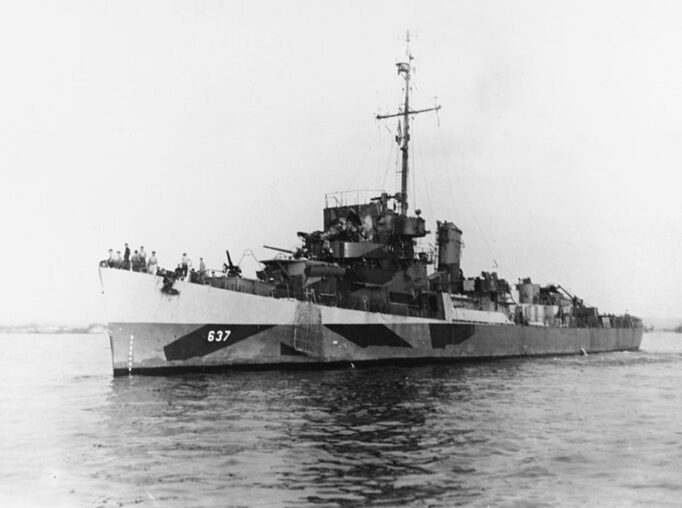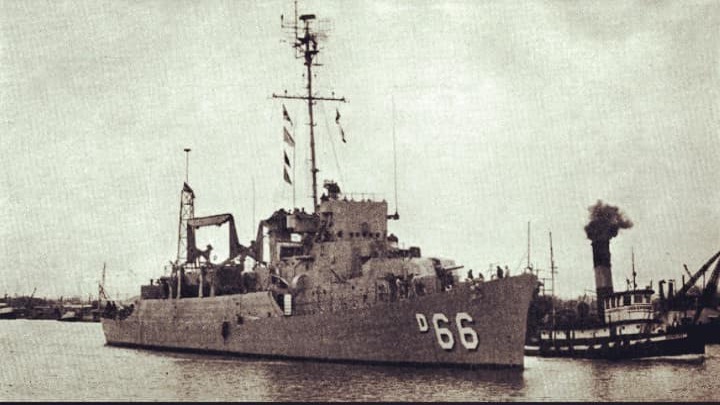On 29-June-1964, the Philippine Navy lost its Flagship and our First Destroyer Escort during the fury of Typhoon Winnie.
The loss of a Flagship is a major loss to any Naval Force; fortunately, during this incident none of the Officers and Crew was lost. Despite the harshness of Mother Nature, the ship’s entire complement fought bravely to save the ship until the end.
For us to determine what transpired on that fateful day, this is her story.
INTRODUCTION
USS BOWERS (DESTROYER ESCORT 637)

The USS Bowers (DE-637) is a Buckley Class Destroyer Escort of the United States Navy commissioned on 27-January-1944 and participated in the major battles of the Pacific War from Operations in New Guinea, the Battle of Leyte Gulf and Okinawa. Her duties included Search and Rescue (SAR), Escort, Naval Gunfire Support, Anti-Submarine operations and Radar picket. She was hit by a Kamikaze on 16-April-1945, killing 37 of the ship’s crew.
She was named after Ensign Robert Keith Bowers 0-84057 USNR, a Seaplane Pilot of Observation Squadron 2 aboard the Battleship USS California (BB-44) killed in action on 07-December- 1941, during the Japanese attack on Pearl Harbor. Ensign Bowers hails from Kittitas County, Washington. He is the Son of Mr Ira Alva and Eunice Bowers of Ellensburg, Washington. Ensign Bowers died during the Japanese first wave of attack while directing the moving up of the ammunition onto the deck of the USS California, as narrated by fellow officers to Ms Dorothy Dietz, the fiancée of Ensign Bowers.
CONVERSION TO HIGH SPEED ATTACK TRANSPORT
On 24-May-1945, as preparations were made for the Destroyer Escort’s conversion to a High-Speed Attack Transport of the Charles Lawrence Class, the conversion would not be finished until after the end of the Second World War. By September 1945, she was involved in trainings and exercises off Cuban waters, after which, she was again decommissioned until February 1951 when recalled into service and became part of the Atlantic Fleet as training vessel for the Marine Corps, USN Underwater Operations Group and Midshipman. By 1954, she was attached to the 6th Naval District and served as a Naval Reserve Training Ship.
On 18-December-1954, USS Bowers (APD-40) was again decommissioned until loaned to the Philippine Navy on 31-October-1960 as part of the Military Assistance Plan (MAP). By 21- April-1961, she was bought thereat by the Philippine government and commissioned into the Philippine Navy as RPS Rajah Soliman (D-66) and classified as a Destroyer Escort.
RPS RAJAH SOLIMAN (D-66)
The biggest ship in the Philippine Fleet at that time, RPS Rajah Soliman (D-66) served the country and the Navy for three years and six months until her demise. It is the only ship in her class inducted in the Philippine Fleet.
NAMESAKE
She was named after one of the three famed rulers of Manila during the 15th Century, Rajah Soliman, along with Rajah Matanda and Rajah Lakandula who opposed the Spanish conquest of Manila. A very fitting name for a warship that symbolizes a Filipino patriot and warrior.
TECHNICAL SPECIFICATIONS
During transfer to the Philippine Navy, now a high-speed Charles Lawrence Class Attack Transport, she had the following specifications:
- Displacement (full load): 2,130 tons;
- Dimensions (L x W x D): 93.3 x 11.2 x 3.9 meters;
- Armaments (in Philippine service):
- Guns : 1 x single 5″/38 Mk 26 DP, 3 x twin 40mm AA,
- 2 Depth Charge racks and 3 Torpedo tubes with 21-inch Torpedoes;
- Cargo capacity: 4 LCVP landing crafts, 6 1/4-ton trucks, 2 1-ton trucks, 4 ammunition carts, 4 packs howitzers, Storage, Ammunition 6,000 cu. ft.;
- General Cargo 3,500 cu. ft.;
- Gasoline 1,000 cu. ft.; Troop Capacity: 150 men, Depth Charge Capacity: 200; Powerplant: Two boilers driving 2 GE turbo-electric drive turbines: 12,000 bhp driving 2 shafts;
- Max Speed: 23.6 knots; Range: 11,000 at 12 knots; Ship crew: 12 Officers, 186 Men.
Tabulated Record of Movement (TROM): RPS Rajah Soliman was loaned and acquired during the administration of President Carlos P Garcia though none of the ship’s tabulated record of movement can be found during this period. However, during the incumbency of President Diosdado Macapagal, the ship would take the President on his various trips on reaching far flung areas of the country along with the First Lady Eva Macapagal and the Staff. Notable of these trips were of the visits made by the President on Burias Island on 27-December-1962. Some of the ship’s missions earlier in 1962 when she was dispatched to Singapore was to pick up excess passengers –Muslim pilgrims of MS Taipooan, which was apprehended by Singaporean authorities for overloading.
Apart from her primary mission of conducting patrols on our vast territorial waters, RPS Rajah Soliman participated in various local and bilateral naval exercises with our American counterparts.
TYPHOON WINNIE (LOCAL NAME: TYPHOON DADING)
Typhoon WINNIE begun on 24-June-1964, a Category 3 typhoon, it was the most destructive typhoon to hit the country in 30 years, as it hit Manila and nearby provinces on 29-June-1964. Manila experienced a total black out due to the effects of the typhoon with several structures damaged, leaving people homeless with about 500,000 affected.
It had a peak speed of 115 mph per minute or 185 km per hour. It left the country on 04-July-1964 with destination China.
TYPHOON WINNIE and RPS RAJAH SOLIMAN:
As noted earlier, the typhoon hit Manila on 29-June, when RPS Rajah Soliman was already at the Ship Repair Facility (SRF) in Mariveles, Bataan. As narrated by Sir Jun Nonato (Son of Commander Godiardo Guinson Nonato 0-1976 PN PMA Class of 1944, skipper of RPS Rajah Soliman during the sinking), in his memoirs and as narrated by the crew of D-66 to him after the disaster that they tried to save the ship but they were no match to the waves with which the ship was pushed to the concrete sea wall and pier.
Fighting hard to keep her afloat by pulling the towlines inland, but the fury of Mother Nature had taken over. After giving the order to abandon ship, Commander Nonato decided to stay behind but was pulled out in time by his crew as a chunk of metal felled from the mast almost hit him.
Since the ship was undergoing repair during that period, its engines were removed, in which Sir Jun overheard his father said that if the engines were there, he would have taken her out to sea with much chances of saving her. But again, it must have been God’s will as if the ship was taken out to open sea, loss of life might have occurred with the typhoon’s fury.
Also of note, Typhoon Winnie’s local name was Dading, which is also the nickname of Commander Nonato. He was court martialed for the incident as possible culpable neglect but was later cleared of charges, though sadly his naval career suffered as he was eventually bypassed for promotion to Navy Captain (equivalent to Army Colonel).
The ship’s superstructure and starboard side were badly battered by the pounding waves that caused its eventual capsizing. The debris and mud further deteriorated the wreck.
THE SKIPPER
COMMANDER GODIARDO GUINSON NONATO was born on 02- March-1919 in Bacolod, Negros Occidental. Prior to joining the Philippine Military Academy in 1940, he was enrolled at the University of the Philippines-Diliman College of Engineering. He Graduated with the Class of 1944 of the Philippine Military Academy.
Apart from his General Staff Course (GSC) and other local schooling, he had taken United States Navy’s Highly Specialized Mine Warfare Course at the US Naval Mine Warfare School, Yorktown, Virginia. Commander Nonato was the Philippine Representative for the course along with 11 other Naval Officers from Argentina, Belgium, Brazil, Denmark, Germany, Japan, Taiwan, Thailand, Turkey, Republic of Korea, and Sweden.
Prior to becoming the Skipper of RPS Rajah Soliman, he was the Commander of the Headquarters and Service Group, Cavite Naval Base. He took Command of RPS Rajah Soliman sometime in early 1963 until its sinking in 1964.
He married the former Ms Coleta Oquias and had seven children namely: Lysander, Cynthia, Godiardo Jr, Jocelyn, Tyrone, Kyster, and Yvette.
RETIREMENT AND POST NAVAL CAREER
Captain Nonato retired in 1969 at the age of 50 with last rank held as Navy Captain, after which he joined Ysmael Shipping and shuttled between Manila and Hong Kong as part of his job. After his stint with the Shipping Company, he did contract repair works with the Navy. His last job before retiring for good was as the Administrative/Personnel Manager of Feagle Enterprises.
DEATH
CAPTAIN GODIARDO G NONATO PN passed away on 06- November-2000 at age 81.
SALVAGING and RAISING RPS RAJAH SOLIMAN:
The PARBUCKLE SYSTEM
Based on the book Mud, Muscle and Miracle by Captain Charles Bartholomew USN and Commander William Milwee Jr USN, after the typhoon’s departure, plans were made by the Philippine Navy to salvage the ship as it lay on 24 feet of water and 8 feet of mud with a 150-degree list. Philippine Navy Salvage Operators using pontoons were able to bring the ship to 10 degrees. Discussion later revolved around whether it was worthwhile to salvage D-66 considering the cost and if she was still repairable despite the damage she took on her structure and hull.
The Philippine Navy dilemma of salvaging the ship became known to the Chief Salvage Officer of the USN’s Pacific Fleet Commander Eugene B Mitchell. As stipulated in the Military Assistance Pact, ships and equipment when no longer needed by the allies reverts back to United States control or ownership. Thus, on 9-December-1964, D-66 reverted back to US Control.
The Salvage Process took almost a month beginning 16-January-1965 and ending on 18-February-1965, though to put the ship in the upright position took only 13 days and with the remaining two weeks for dewatering, de-ballasting, and cleaning of mud and debris. Five Parbuckling attempts were conducted for the salvage operation.
I have consulted two notable publications with regards to the raising of RPS Rajah Soliman (D-66) that covers in detail the Salvage Operation conducted, Methods Used and Forces involved. These are (1) Mud, Muscle and Miracle by Captain Charles Bartholomew USN and Commander William Milwee Jr USN; and (2) Harbor Clearance Operations by the U.S. Navy’s Naval Sea Systems Command released in 1989.
